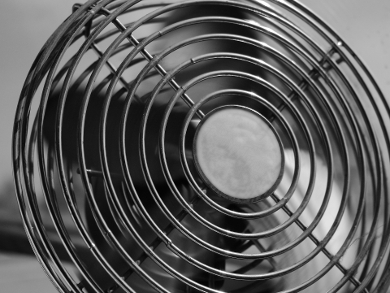In public and private buildings as well as in transport vehicles, people are inevitably confronted with a broad spectrum of foreign substances, via both the air and dust residues. Apart from sources contingent upon the site itself, people also play a role in direct contamination. They contribute through such diverse activities as cleaning, cooking, office work, smoke from both conventional and electronic cigarettes, or through metabolic processes, releasing chemical compounds into the confined ambient air.
The following brief foray through a few relevant topics, with an emphasis on indoor climates and gaseous and particulate materials, should help clarify both the diversity and the interdisciplinarity of the chemistry of indoor air.
1. A New Field of Research — Indoor Air
Examining foreign matter in ambient air is a relatively new area of research. Starting with observations on “Los Angeles smog”, Haagen-Smit in 1952 [1] published the first systematic work on damage to plants through reactions with trace organic materials. After the Second World War, the city of Los Angeles, California, USA, began to suffer serious problems associated with air pollution caused by automobile exhaust gases. In 1960, Went [2] emphasized particularly the role played in optical phenomena in the atmosphere by oxidation processes of biogenic hydrocarbon emissions. The focus was initially on a small number of substances or substance classes relevant to outdoor air. It was not until the mid-1970s that the indoor situation developed into an independent field of research.

Figure 1. Max von Pettenkofer (1818–1901) was the founder and director of the Institute for Hygiene in Munich, Germany, as well as the first academic chair for hygiene at the University of Munich. He dedicated himself especially to combatting cholera and typhus. With his work on carbon dioxide in residential air, as well as on ventilation, he also is considered to be a pioneer in interior hygiene.
The general theme of interior hygiene had already attracted practical interest 150 years earlier in the age of the industrial revolution and an associated wave of mass construction of housing. Work by the British author Thomas Tredgold [3], for example, on the subject of ventilation, first appeared in 1824. In Germany, progress was above all due to Max von Pettenkofer (see Fig. 1), who in 1858 published a paper on ventilation in residential buildings. It was Pettenkofer who in the mid-19th century also proposed a maximum carbon dioxide concentration of 1000 ppm (0.1 volume percent) as the criterion for a well-ventilated room. The “Pettenkofer number” served for many decades as an essential criterion for calculating ventilation requirements. It was not until 2008 that a commission of the German federal environmental agency presented instead a graduated benchmark concept for CO2 [5].
After von Pettenkofer there was for over 100 years virtually no advance in research into indoor ventilation. Especially the period from the 1950s until the early 1970s was characterized from an environmental standpoint by other matters. Rachel Carson’s book “The Silent Spring”, which appeared in 1962, is often regarded as the point of origin for a major new environmental movement. In the wake of a subsequent debate over the use generally of biocides, by 1972 the long-cherished dichlorodiphenyltrichlorethane (DDT) had been banned in nearly all countries. This was not true in the former East Germany, however, where DDT-containing products continued to be used within buildings until 1989 under the name HYLOTOX. Interior space came into focus again after 1975 as a result of a publication by the Danish authors I. Andersen et al. [6] regarding frequent high concentrations of formaldehyde in interior spaces. Around ten years later, a discussion broke out over the indoor use of biocides, which led in Germany in 1989 to a new prohibition of pentachlorophenol (PCP). The World Health Organization (WHO) took a first stand against possible health risks due to indoor air pollutants in 1979 [7].
In 1992, the American research group of Charles Weschler and his colleagues [8] bridged the gap between interior-air investigations and general atmospheric chemistry with a publication concerning ozone reactions in confined spaces, where the term “indoor chemistry” was coined. A further milestone that brought indoor air chemists and epidemiologists closer together was reached in 2003 when the American research group of J. Angerer managed to establish human biomonitoring of phthalate esters as a routine analytical procedure [9].
2. Chemical Characterization of Indoor Air
2.1. An Ideal Stirred-Tank Reactor
In its simplest form, indoor space can be seen as analogous to an ideal stirred-tank reactor. Here air is continuously both introduced and led away, and it is thoroughly mixed within the room itself (see Fig. 2).

Figure 2. Box model of an interior space.
One can imagine that a substance is released from some arbitrary source into such room air, or perhaps brought in via the external air. The further fate of this substance then depends on various factors, as presented in the blue box below.
If the introduced substance has a sufficiently high vapor pressure, it will exist preferentially in the gas phase. The residence times of such a substance will depend mostly on ventilation in the room.
A typical example might be the nonpolar benzene molecule, with a boiling point of 80 °C (at 1013 mbar) and a vapor pressure of 100 hPa (293 K). The theoretical average residence time τ of a molecule in a room can be calculated from the reciprocal of the ventilation rate. With a ventilation n = 0.5 h–1, i.e. an hourly replacement of 50 % of the air volume of the room, one arrives at a value τ = 2 h.
|
Model of an Interior Space
where V (m3) represents the volume of the room, and Moreover, it is usually necessary to consider multiple sinks and reaction pathways. The mass balance equation can, therefore, be solved only for simple scenarios, which can be realized in emission chambers. Often, one takes for simplification a stationary case, with dCin /dt = 0, where one neglects potential sinks and reactions. This leads with ER = |
2.2. Molecules in Various Phases
The stirred-tank model is applicable only to volatile substances. Non-volatile molecules such as the plasticizer di-2-ethylhexylphthalate (DEHP), with a vapor pressure of 2.5 × 10–5 Pa, are present to an extent of less than 10 % in the gas phase, and they condense preferentially on airborne particles or other surfaces.
Many of the materials present in a room, such as textile floor coverings and plasterboard, function, as a consequence of their surface characteristics, as sinks for inorganic and organic compounds. The absorption capacity of these surfaces is normally limited, so that adsorbed or absorbed substances are, after a certain period of time, set free again into the gas phase.

Figure 3. Classification of organic compounds: V VOC = very volatile organic compound; VOC = volatile organic compound; SVOC = semi-volatile organic compound; POM = organic compound associated with particulate organic matter.
For an estimate of human exposure within a confined space it is of fundamental importance to understand whether a molecule accumulates in the gas phase, in the particle phase, or in sedimented household dust (see Fig. 3). Volatile compounds are inhaled, and as the case may be, also absorbed through the skin. Moderately volatile and nonvolatile compounds are largely particle-bound. Airborne particles can also be inhaled. In the case of household dust, intake occurs over the gastro-intestinal tract or through direct skin contact.
2.3. Box-like Emission Chambers
The dynamics of substances at the molecular and particle level in a completely furnished room can only be described with difficulty, and indeed may be impossible to describe. Furthermore, real rooms are always subject to temperature and humidity variation. For the study of chemical and dynamic processes, one, therefore, often takes advantage of box-like emission chambers, in which the climate (temperature, humidity, ventilation) is adjustable in a well-defined and controllable way.
To minimize undesired sink effects, interior walls of these chambers are normally fabricated from polished stainless steel. Such an experimental design permits targeted investigation of substance emission from materials and products via diffusion processes, or also from interactions between specific compounds and materials [10]. For a sophisticated experimental set-up one typically requires a chamber size between 1 m3 and 50 m3 [11].
2.4. Reactions in Room Air
Chemical reactions taking place in room air are also receiving ever more attention, where ozone and monoterpenes play a significant role. Substances like α-pinene and limonene are released into room air from various sources, such as conifers, cleaning agents, and aromatic sprays; concentrations in room air on the order of 50 ppb are not uncommon. In the case of ozone, concentration values of 20 ppb in room air may be quite realistic.
For limonene, the rate constant for bimolecular reaction with ozone according to equation (2) is kO3 = 200 · 10–18 cm3 molecule–1 s–1. For α-pinene, the corresponding bimolecular rate constant based on equation (2) is kO3 = 87 · 10–18 cm3 molecule–1 s–1.
![]() (2)
(2)
As a result of this reaction (see Fig. 4) one obtains initially, by way of the ozonide and the Criegee intermediate, various OVOCs (oxygenated volatile organic compounds). Furthermore, the vapor pressures of the oxidized terpenes are significantly lower than those of the terpenes themselves. This leads in turn to condensation, and the formation of nanoparticles.
There has been discussion about the role played by OVOCs in the health assessment of room air [14]. With the aid of suitable test chambers, it is possible to thoroughly explore reactions of terpenes with ozone under simulated interior room conditions. Within a few minutes after initiation of such an experiment, one begins to observe terpene decomposition, consistent with Equation (2), with a simultaneous significant increase in the presence of secondary organic aerosols (SOAs) [15].
.png)
Figure 4. Formation of nanoparticles from terpene/ozone reactions. (The figure was derived from [12], based on [13].
2.5. What is Typically Present in Room Air?
Compilation of all the compounds, particles, and fiber types that may occur in room air would be a project just as arduous as it would be time-consuming [16]. Routinely, more than 1000 inorganic and organic compounds might be detected. If combustion processes are also taken into account, the number of possible components tends instead to approach 10 000.
For pragmatic reasons, one classifies (consistent with the World Health Organization) organic compounds present (crudely) according to their boiling points; transitions between the various categories tend to be quite fluid (see Fig. 3) [17]. From a chemical point of view, vapor pressure would be a significantly more appropriate parameter, but for most nonvolatile and moderately volatile compounds, not enough vapor pressures are known, or they are associated with great uncertainties.
Very volatile compounds like butane or acetaldehyde are categorized as V VOCs (very volatile organic compounds). Typical solvents like ethylbenzene or n-butyl acetate belong instead to the category of VOCs (volatile organic compounds). Relatively nonvolatile compounds, including many phthalates, are found in the category SVOCs (semi-volatile organic compounds). Finally, there is a category for POMs (organic compounds associated with particulate organic matter), compounds found essentially only in particle-bound form. These include higher polycyclic aromatic hydrocarbons and various biocides. Note that so far there exist no precise definitions for V VOCs, SVOCs, or POMs [18].
From the classification series illustrated in Figure 3, one can easily guess over what pathways people may have gone out on a limb in devising it. A precise analytical definition exists so far only for the VOC category, through ISO 16000-6 [19].
Table 1 offers a rough compilation of typical substances and substance groups. Many substances will already be found present in a primary sense in the appropriate repository. But it is often the case that secondary products also arise: through chemical reactions. Hydrolysis, thermal decomposition, Diels-Alder reactions, and photoreactions are well-known examples, with documented cases occurring under room conditions [22]. In addition, metabolic processes involving people, animals, plants, and fungi must be taken into account.
Table 1. Typical substances and substance groups found in room air. The figure provides a crude overview of the most important substances and substance groups. Monographs are available for detailed introduction into the subject matter [16, 20, 21]. (PAHs = polycyclic aromatic hydrocarbons)

Characterizations of possible emission sources can prove comparably wide-ranging. The composition of atypical indoor air components is influenced by a practically unimaginable number of materials, as well as interactions between materials and processes. For example, it has been known for many years that formaldehyde is released from composite wood materials assembled using urea/formaldehyde resins. Much less known, however, is the fact that combustion of ethanol in a chafing dish, for example, can also lead to extremely high formaldehyde concentrations in room air. Vacuum cleaners lacking special filters collect household dust very effectively, but they also increase the air concentration of fine dust (PM10), in that they subsequently again release dust fragments via their blowers. A list of further examples of how, with our lifestyles, we release foreign materials into room air could be lengthy indeed.
Biological Impurities
Best known among biological room-air impurities are mold fungi, such as Penicillium and Aspergillus. In general, mold infestations constitute a major source for mycotoxins and biological particles in breathing-air and dust. Microorganisms also produce a broad spectrum of odorous volatile organic metabolites, known as MVOCs (microbiologically originating volatile organic compounds). The compounds themselves are mainly various alcohols (e.g., 1-octene-3-ol), ketones (e.g., 3-octanone), sulfur compounds (dimethyldisulfides), etc. [23].
Radon
A very common, but still often underestimated indoor air contaminant, is the radioactive rare gas radon, which as the nuclide Rn 222 is formed in the disintegration series for U-238, and as Rn-220 in the series for Th-232. Of special significance from a health standpoint is Rn-222, which forms also from Ra-226, and is an α-source that decays with a half-life of a scant four days
Rn-222 from natural sources plays a significant role in the natural human radiation burden. It occurs in uranium-containing rocks and finds its way into the room-air of residences through building foundations, primarily due to leaks in basements and ground floors, or from radium-containing building materials. Radon can also gain entry to household air through cracks or seams in foundations, or ducts for cables or pipes into basement rooms, but also by diffusion and permeation processes made possible by the pore system of concrete.
The metallic radon decay products Pb-218, Pb-214, Bi-214, and Po-214 can accumulate on dust particles, and in this way become deposited in the lungs. Radon in closed rooms is a significant human risk factor with respect to lung cancer [24].
References
[1] A. J. Haagen-Smit, Ind. Engi. Chem. 1952, 44, 1342–1346.
[2] F. W. Went, Nature 1960, 187, 641–643.
[3] T. Tredgold, The Principles of Warming and Ventilating Public Buildings, J. Taylor, London, UK, 1824.
[4] M. von Pettenkofer, Über den Luftwechsel in Wohngebäuden, Cotta’sche Buchhandlung, München, 1858.
[5] Ad hoc AG, Bundesgesundheitsblatt 2008, 51, 1358–1369.
[6] I. Andersen, G. R. Lundqvist, L. Mølhave, Atmos. Environ. 1967, 1975, 9(12), 1121–1127. https://doi.org/10.1016/0004-6981(75)90188-2
[7] World Health Organization, Health Aspects Related to Indoor Air Quality, EURO Reports and Studies, Copenhagen, 1979.
[8] C. J. Weschler, A. T. Hodgson, J. D. Wooley, Environ. Sci. Technol. 1992, 26(12), 2371–2377. https://doi.org/10.1021/es00036a006
[9] H. M. Koch, H. Drexler, J. Angerer, Int. J. Hyg. Environ. Health 2003, 206, 77–83.
[10] J. Gunschera, S. Mentese, T. Salthammer, J. R. Andersen, Build. Environ. 2013, 64, 138–145.
[11] T. Salthammer, Environmental Test Chambers and Cells in Organic Indoor Air Pollutants (Eds.: T. Salthammer und E. Uhde), Wiley-VCH, Weinheim, 2009, pp. 101–115.
[12] T. Salthammer, Chemosphere 2011, 82, 1507–1517.
[13] T. Hoffmann, C. Zetzsch, M. J. Rossi, Chem. Unserer Zeit 2007, 41, 232–246.
[14] P. Wolkoff, S. T. Larsen, M. Hammer, V. Kofoed-Sorensen, P. A. Clausen, G. D. Nielsen, Toxicol. Lett. 2013, 216, 54–64.
[15] J. Toftum, S. Freund, T. Salthammer, C. J. Weschler, Atmos. Environ. 2008, 42, 7632–7640.
[16] A. Schieweck, T. Salthammer, Schadstoffe in Museen, Bibliotheken und Archiven, Fraunhofer IRB Verlag, Stuttgart, 2014.
[17] World Health Organization, Indoor air quality: organic pollutants, EURO Reports and Studies, Copenhagen, 1989.
[18] T. Salthammer, Indoor Air 2016, 26, 25–38.
[19] ISO 16000-6, Indoor air–Part 6: Determination of Volatile Organic Compounds in Indoor and Test Chamber Air by Active Sampling on Tenax TA Sorbent, Thermal Desorption and Gas Chromatography Using MS/FID, Beuth Verlag, Berlin, 2011.
[20] T. Salthammer, E. Uhde, Organic Indoor Air Pollutants, WILEY-VCH, Weinheim, 2009.
[21] G. Zwiener, F.-M. Lange, Handbuch Gebäude-Schadstoffe und gesunde Innenraumluft, Erich Schmidt Verlag, Berlin, 2012.
[22] E. Uhde, T. Salthammer, Atmos. Environ. 2007, 41, 3111–3128.
[23] W. Mücke, C. Lemmen, Schimmelpilze, ecomed MEDIZIN, Verlagsgruppe Hüthig, Landsberg, 2004.
[24] K. Gertis, Radon in Gebäuden, Fraunhofer IRB Verlag, Stuttgart, 2008.
The article has been published in German as:
- The Air that I Breathe – Der Innenraum als chemischer Reaktor,
Tunga Salthammer,
Chem. unserer Zeit 2017.
https://doi.org/10.1002/ciuz.201700779
and was translated by W. E. Russey.
The Air that I Breathe – Part 1
Chemistry of indoor air is a relatively new, diverse and interdisciplinary field surrounding us every day
The Air that I Breathe – Part 2
How dangerous are my household appliances?
The Air that I Breathe – Part 3
Emissions of e-cigarettes and other drugs
The Air that I Breathe – Part 4
Man as a source of substances, life on Mars, and what to learn from movies
The Air that I Breathe – Part 5
How does climate change affect indoor air quality?
See similar articles by Klaus Roth published in ChemViews Magazine




